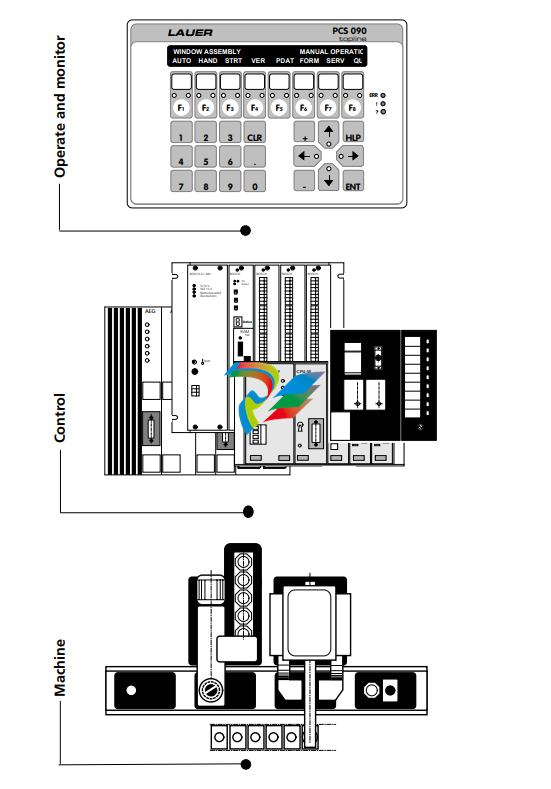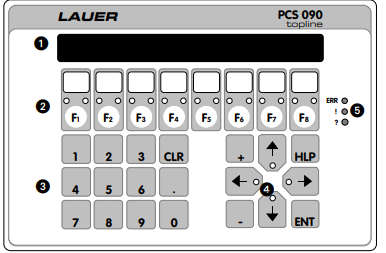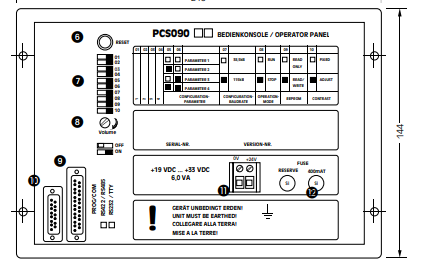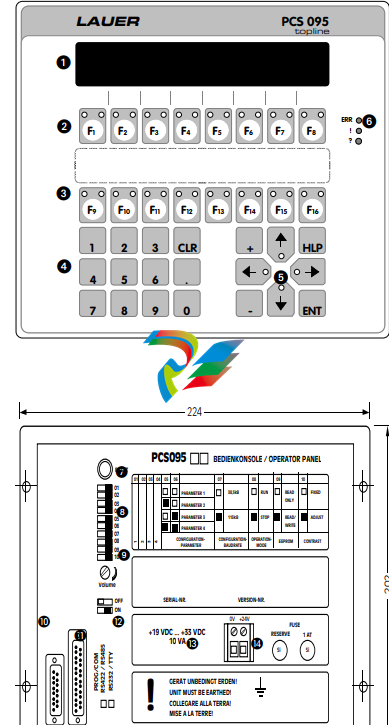
LAUERfor the operating consoles PCS 009, PCS 090, PCS 095, PCS 095.1
for the operating consoles
PCS 009, PCS 090, PCS 095, PCS 095.1
The operating consoles PCStopline offer the
highest degree on perfection, unparalled in
design and function. PCStopline keeps everything under control - from the PCSmini to the
PCSmaxi, with a superior operating culture and
an unlimited setup freedom.
PCS, the first programmable operating console
with a large selection of "ready-to-use" operating functions or operating tools which are
simply selected via instructions. You can realize
even the most unuasal operating requests at
ease and in a minimum of time.
Today this way and tomorrow that way
One standard hardware for virtually thousands
of different operating situations. Without extensive wiring and dozens of I/O points.
PCS for operating. What else?
■ Machine operation using 8 (PCS 009, PCS 090) or 16 (PCS 095, PCS 095.1)
freely assignable keys. These F01 to F08/F16 labeled keys can be application
specifically inscribed and are provided to the controller as status bits.
■ Machine operation using 4 (PCS 009), 16 (PCS 090) or 32 (PCS 095, PCS
095.1) freely usable LEDs. These can be assigned the indicating states ON,
DARK, FLASHING, and INVERSE FLASHING. A green and a yellow LED is allocated
to each function key.
■ Display of fixed texts with integrated variable values. The values can be
represented selectably as numerical values or in text format.
■ Representation of the contents of 233 words as variables. In addition, 650
external variables can be defined. 9 variable formats (from bit to timer) are
available.
■ 3 text groups, 128 operating texts as menu and idle texts, 128 message texts
with up to 332 lines, 5 help texts with up to 32 lines.
■ 127 menus with 255 menu nodes each for any menu configurations.
■ 4 different deletion modes. For every message, 1 of 4 possible deletion modes
can be selected.
■ Modification of the content of any word within the transfer area. Using the
integrated editor all possible representation formats can be setup.
■ 7 priority levels for idle text up to help text, 3 message priorities Information,
Warning, Fault. This working-condition related management significantly offloads the programmable controller program.
■ Monitoring of rising or falling edges of 128 consecutive bits. The assignment
of texts, the manage-ment of 3 priority levels (Information, Warnings, and Faults),
keeping the timely sequence as much as possible, organization of the FIRST
MESSAGE, LAST MESSAGE, and CYCLIC DISPLAY, the individually settable deletion behaviour, and the representation formats NORMAL and FLASHING are tasks
which are managed by the PCS by itself.
■ Communication monitoring (wire-break, short circuit). A very efficient data
transfer is secured by the integrated priority management in connection with the
intelligent package length optimization, the high thruput rate and the fault tole


Operator Panel PCS 009
1 = LCD-Display, 4 lines each with 40 characters
2 = Function keys (also as soft keys) F1...F8 with a
greem message LED
3 = 10 key keyboard for nominal value input
4 = cursor and control keys for menus and nominal
value input
5 = Switch key (Shift key) for function keys (F1..F4,
F5..F9)
6 = Important information LEDs on the PCS status
7 = Reset key
8 = DIL switch for the PCS 009
9 = Volume for acoustic signal
J = Serial interface RS 232/TTY for communication
K = Serial interface RS 422/RS 485 for communication
L = Operating voltage terminals
M = Fuse with reserve fuse


Operator Panel PCS 090
1 = LCD-display, 2 lines each with 40 characters
2 = Function keys (also as soft keys) F1...F8 with a
yellow and green message LED
3 = 10 key keyboard for nominal value input
4 = Cursor keys with LED and cursor control keys for
menus and nominal value input
5 = Important information LED's on the PCS status
6 = Reset key
7 = DIL-switch for the PCS 090
8 = Volume for acoustic signal
9 = Serial interface RS 232/TTY for the communication
J = Serial interface RS 422/RS 485 for the
communication
K = Operating voltage terminals
L = Fuse with reserve fuse


Operator Panel PCS 095/PCS 095.1
1 = LCD-display, 4 lines each with 40
characters
2 = Function keys (also soft keys) F1...F8
each with a yellow and a green
message LED
3 = Function keys F9...F16 each with a
yellow and a green mesage LED
4 = Ten key keyboard for nominal value
input
5 = Cursor key with LED and control key for
menu and nominal value input
6 = Important information LEDs on the PCS
status
7 = Reset key
8 = DIL switch for the PCS 095
9 = Volume for acoustic signals
J = Serial interface RS 232/TTY for the
communication
K = Serial interface RS 422/RS 485 for
the communication
L = Serial interface RS 232/TTY for the
programming and for the PCS 095.1
as Printer interface
M = Operating voltage terminals
N = Fuse with reserve fuse
Communication between any PLC and the PCS occurs as follows:
The PCS writes in predetermined word areas of the PLC, functions or nominal values,
which the PLC then reads and interprets.
The PLC writes in predetermined word areas functions or actual values, which are
automatically read and interpreted by the PCS. Independently of the PLC there are
maximum 256 words of 16 bit, that is to say 4096 inputs / outputs for the PCS/PLC
communication available.
... and rapid set-up of a particular operational requirement
1 First define the specification and decide on the required PCS (PCS micro, PCS
mini, PCS midi or PCS maxi)
2 Allocate the word and bit number to variables (actual- and nominal values).
3 Create the texts for operational guidance and help functions as well as for
displays of machine conditions.
4 Determine the message texts and apply these words to them, subdivide the
message texts into 3 priority groups
■ Information
■ Warnings
■ Faults
and take into consideration the differing cancel modes, display and message
modes. Display and message modes can be altered by the PLC at any time.
5 Define the menus and the menu operating texts.
6 Transfer the data file (variables, texts, menus) which was made in the PC or PG
under MSDOS/DRDOS or compatible DOS-system, with the software PCSPRO
into the PCS.
7 Implement and parameterize the PLC specific operating software (PCS 91.nn,
see overall view of information) in the users' programme.
8 Connect the PCS via the adapter cable with the PLC. Test together the operation
and control of the PCS and PLC and adjust if necessary
Machines produce different parts. Therefore quick and selective alterations of finished
sizes and functions (variables) are especially important for increased flexibility.
The PCS features a convenient method of processing the variables. 650 external variables (freely definable) and 6 internal variables are supervised from the PCS.
The value of the external variables are stoped in the words
30...255. The PCS differentiates
between actual values and nominal values:
ACTUAL: The value in the word
is the actual value. The PCS can
only display the value.
NOMINAL: The standing value
in the word is the nominal value.
The value can be displayed and
changed by the PCS.
NOMINAL VALUE-P: The private value in the word is a nominal value. The PCS can display
the value. It can be changed only
if this is allowed by the word 14
bit 7 = log 1 (key switch or DILswitch 1...4 on the rear side of
the PCS). When the bit 7 of word
14 = log 0, the display of the
actual value follows.
Internal Variables
NAME CONTENTS FORMAT LENGTH ACTUAL/NOMINAL
ZP NUMBER OF INFORMATIONS BIN 3 ACTUAL
ZQ NUMBER OF WARNINGS BIN 3 ACTUAL
ZR NUMBER OF FAULTS BIN 3 ACTUAL
ZT MENU NUMBER BIN 2 ACTUAL
ZV SCROLL TIME BIN 2 NOMINAL
ZX INTERFACE FAULTS BIN 2 ACTUAL
External Variables
FORMAT, LENGTH
BIT variable max. length 40 characters
STRING variable max. length 40 characters
CSTRING variable max. length 40 characters
WORD variable KM, KH, KY: length: 17, 4, 7 characters
ASCII variable max. length 16 characters
BCD-1 variable max. length 4 digits
BCD0-1 variable *) max. length 4 digits
BCD-2 variable max. length 8 digits
BCD0-2 variable *) max. length 8 digits
BIN-1, BIN-A variable max. length 16 bits/11 digits
BIN0-1, BIN0-A variable *) max. length 16 bits/11 digits
BIN-2, BIN-B variable max. length 32 bits/11 digits
BIN0-2, BIN0-B variable *) max. length 32 bits/11 digits
VBIN-1, VBIN-A variable max. length 16 bits/11 digits + operational sign
VBIN0-1, VBIN0-A variable *) max. length 16 bits/11 digits + operational sign
VBIN-2,V BIN-B variable max. length 32 bits/11 digits + operational sign
VBIN0-2, VBIN0-B variable *) max. length 32 bits/11 digits + operational sign
Timer variable max. length 40 characters
*) BIN0...- and VBIN0... variable are only programmable with PCSPRO
The BIT variable
When two possibilities can be selected at an input, the descision is taken by the bit
variable. This is in the form of an ON/OFF switch.
Every switch position represents an inscription (text) which appears in the display.
Each bit variable occupies a bit. A data word can also take on up to 16 differing bit
variables or switches.
Example: A wood shavings vacuum absorption cleaner shall be switched on or off
in bit 2 data word 33.
The +/- switch selects the inscription or the switching position. The bit bears the value
of the inscription. The first inscription carries the value log 0, the second bears the
value log 1.
STRING variable
When two or more possibilities can be selected at an input, the decision is made by
the STRING variable. It corresponds to a selector switch.
With STRING variables, every switch position is classified with an inscribed text, which
appears in the display. Every STRING value carries a data word with up to 256 switch
positions. The switch position is deposited in low bytes of the data word.
Example: The frame material shall be selected in data word 40.
The inscription or switching position is selected with the +/- key. Acceptance follows
with the ENTER key.
CSTRING variable
The CSTRING variable corresponds to STRING variable. Acceptance follows directly
after using the +/- key without ENTER.




























































































































